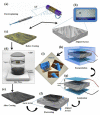Biopolymer Coatings for Biomedical Applications
- PMID: 33371349
- PMCID: PMC7767366
- DOI: 10.3390/polym12123061
Biopolymer Coatings for Biomedical Applications
Abstract
Biopolymer coatings exhibit outstanding potential in various biomedical applications, due to their flexible functionalization. In this review, we have discussed the latest developments in biopolymer coatings on various substrates and nanoparticles for improved tissue engineering and drug delivery applications, and summarized the latest research advancements. Polymer coatings are used to modify surface properties to satisfy certain requirements or include additional functionalities for different biomedical applications. Additionally, polymer coatings with different inorganic ions may facilitate different functionalities, such as cell proliferation, tissue growth, repair, and delivery of biomolecules, such as growth factors, active molecules, antimicrobial agents, and drugs. This review primarily focuses on specific polymers for coating applications and different polymer coatings for increased functionalization. We aim to provide broad overview of latest developments in the various kind of biopolymer coatings for biomedical applications, in order to highlight the most important results in the literatures, and to offer a potential outline for impending progress and perspective. Some key polymer coatings were discussed in detail. Further, the use of polymer coatings on nanomaterials for biomedical applications has also been discussed, and the latest research results have been reported.
Keywords: bioactivity; biomedical applications; biopolymers; coatings; nanoparticles; tissue engineering.
Conflict of interest statement
The authors declare no conflict of interest.
Figures











References
-
- Makhlouf A.S.H., Perez A., Guerrero E. Advances in Smart Coatings and Thin Films for Future Industrial and Biomedical Engineering Applications. Elsevier Inc.; Amsterdam, The Netherland: 2019. Recent trends in smart polymeric coatings in biomedicine and drug delivery applications; pp. 359–381. - DOI
-
- Augello C., Liu H. Surface Modification of Magnesium and its Alloys for Biomedical Applications. Volume 2. Elsevier Ltd.; Amsterdam, The Netherlands: 2015. Surface modification of magnesium by functional polymer coatings for neural applications; pp. 335–353. - DOI
-
- Leontidis E. Langmuir-Blodgett Films: Sensor and Biomedical Applications and Comparisons with the Layer-by-Layer Method. In: Gursoy M., Karaman M., editors. Surface Treatments for Biological, Chemical and Physical Applications. Wiley-VCH Verlag; Weinheim, Germany: 2016. pp. 181–208. - DOI
Publication types
LinkOut - more resources
Full Text Sources

